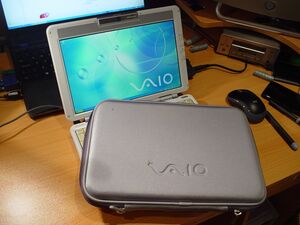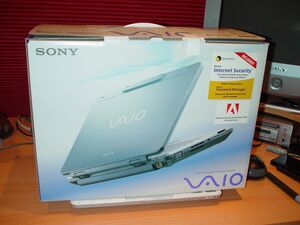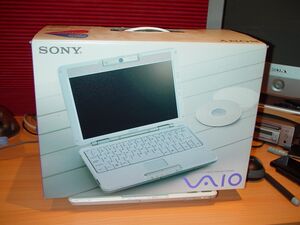PCG-TR: Difference between revisions
More actions
No edit summary |
|||
| (6 intermediate revisions by 3 users not shown) | |||
| Line 1: | Line 1: | ||
{{DISPLAYTITLE:PCG-TR}} | {{DISPLAYTITLE:PCG-TR}} | ||
WIP!!! | |||
== Overview == | == Overview == | ||
[[File:PCG-TR with DVD drive.jpg|thumb|PCG-TR with DVD drive]] | [[File:PCG-TR with DVD drive.jpg|thumb|PCG-TR with DVD drive]] | ||
[[File:PCG-TR from top.jpg|alt=PCG-TR from top|thumb|PCG-TR from top]] | [[File:PCG-TR from top.jpg|alt=PCG-TR from top|thumb|PCG-TR from top]] | ||
The Sony VAIO PCG-TR was a ultraportable laptop released by Sony in 2003. It was praised for being light weight (1.4kg), having long battery life and good connectivity (Modem, Ethernet and Wireless). NoteBook review said "If you're a journalist, frequent traveler or just a sucker for small size devices then the VAIO TR5 will give you fantastic functionality in a nice and stylish little package". It shares some design aspects with the Sony VAIO PCG-C1 series, most notably its rotating camera above the screen for capturing still photos and video and the "capture" button located on the side of the screen, which instantly took a picture and opened Sony's camera capture utility. Below the "capture" button was a "zoom" button that quickly changed screen resolution incase the text on the display was too hard to read due to the high resolution display. Another feature of some models in this range are the inbuilt DVD burner located under the keyboard, which was quite an achievement for such a small laptop. It had speakers right above the screen which provided a frankly horrible sound, being | [[File:PCG-TR with case.jpg|alt=PCG-TR with case|thumb|PCG-TR with case]] | ||
The Sony VAIO PCG-TR was a ultraportable laptop released by Sony in 2003. It was praised for being light weight (1.4kg), having long battery life and good connectivity (Modem, Ethernet, Bluetooth and Wireless). NoteBook review said "If you're a journalist, frequent traveler or just a sucker for small size devices then the VAIO TR5 will give you fantastic functionality in a nice and stylish little package". | |||
It shares some design aspects with the Sony VAIO PCG-C1 series, most notably its rotating camera above the screen for capturing still photos and video and the "capture" button located on the side of the screen, which instantly took a picture and opened Sony's camera capture utility. | |||
Below the "capture" button was a "zoom" button that quickly changed screen resolution incase the text on the display was too hard to read due to the high resolution display. Another feature of some models in this range are the inbuilt DVD burner located under the keyboard, which was quite an achievement for such a small laptop. It had speakers right above the screen which provided a frankly horrible sound, being labeled "tinny, not very loud and just plain poor". Sony did however include a headphone jack which supports Dolby. | |||
[[File:PCG-TR from back.jpg|thumb|PCG-TR from back]] | [[File:PCG-TR from back.jpg|thumb|PCG-TR from back]] | ||
The Pentium M 1.10GHz | [[File:PCG-TR Box1.jpg|alt=PCG-TR Box|thumb|PCG-TR Box]] | ||
The battery life on this VAIO was something praised most by reviewers such as NotebookReview.com. They claimed it to easily run for 3.5 hours while watching DVDs, over 5 hours when not watching DVDs or using WiFi (Journalists!) and up to 11 hours on the extended battery pack, sold by Sony separately (PCGA-BP3T). It does get quite hot when doing resource intensive tasks such as watching movies and it is recommended not to use it on your lap. The touchpad is very small and they keyboard misses some keys such as the Page up/Page down, but it overall provides a nice typing experience. Below the keyboard is a inbuilt Memory-Stick reader, without SD card functionality. | |||
The Pentium M 1.10GHz wasn't very powerful at the time, but the RAM of up to 1GB on some configurations made the performance "very good". Startup time was recorded at 40 seconds to boot into Windows XP Pro, but if you replace the HDD with an SSD today, it will be much faster. | |||
== Detailed specs == | == Detailed specs == | ||
| Line 19: | Line 29: | ||
'''Display:''' 10.6" Widescreen 1280x768 XBRITE LCD TFT | '''Display:''' 10.6" Widescreen 1280x768 XBRITE LCD TFT | ||
'''Storage:''' 30GB - 40GB IDE HDD, DVD-RW drive (some models) | '''Storage:''' 30GB - 40GB 1.8" 4200rpm IDE HDD, DVD-RW drive (some models) | ||
'''Weight:''' 1.4kg | '''Weight:''' 1.4kg | ||
| Line 28: | Line 38: | ||
'''Camera:''' CMOS 370,000 pixels (VGA 640×480) MotionJPEG | '''Camera:''' CMOS 370,000 pixels (VGA 640×480) MotionJPEG | ||
== Problems == | |||
The cameras, along with a lot of CCD sensors made by Sony in this era are very prone to fail. Most of the PCG-TR cameras are dead for this reason, so if you are buying one do not expect the camera to work. | |||
== Daily usage today == | == Daily usage today == | ||
The PCG-TR is powerful enough for word processing, basic internet (as long as the site | The PCG-TR is powerful enough for word processing, basic internet (as long as the site doesn't have any animations) and (of course) media playback. It is recommended that one upgrades the HDD to an SSD and the RAM, although keep in mind microDIMMs are quite expensive these days. Obviously you cannot game on this laptop, apart from some basic games such as Space Cadet Pinball, as its graphics performance was poor even back in 2003. If you rebuild the battery it could be a very good laptop to take on travels and even for a journalist, it could be great due to its long battery life. | ||
[[File:PCG-TR Box2.jpg|alt=PCG-TR Box|thumb|PCG-TR Box]] | |||
== Resources == | == Resources == | ||
Latest revision as of 00:06, 13 February 2025
WIP!!!
Overview



The Sony VAIO PCG-TR was a ultraportable laptop released by Sony in 2003. It was praised for being light weight (1.4kg), having long battery life and good connectivity (Modem, Ethernet, Bluetooth and Wireless). NoteBook review said "If you're a journalist, frequent traveler or just a sucker for small size devices then the VAIO TR5 will give you fantastic functionality in a nice and stylish little package".
It shares some design aspects with the Sony VAIO PCG-C1 series, most notably its rotating camera above the screen for capturing still photos and video and the "capture" button located on the side of the screen, which instantly took a picture and opened Sony's camera capture utility.
Below the "capture" button was a "zoom" button that quickly changed screen resolution incase the text on the display was too hard to read due to the high resolution display. Another feature of some models in this range are the inbuilt DVD burner located under the keyboard, which was quite an achievement for such a small laptop. It had speakers right above the screen which provided a frankly horrible sound, being labeled "tinny, not very loud and just plain poor". Sony did however include a headphone jack which supports Dolby.


The battery life on this VAIO was something praised most by reviewers such as NotebookReview.com. They claimed it to easily run for 3.5 hours while watching DVDs, over 5 hours when not watching DVDs or using WiFi (Journalists!) and up to 11 hours on the extended battery pack, sold by Sony separately (PCGA-BP3T). It does get quite hot when doing resource intensive tasks such as watching movies and it is recommended not to use it on your lap. The touchpad is very small and they keyboard misses some keys such as the Page up/Page down, but it overall provides a nice typing experience. Below the keyboard is a inbuilt Memory-Stick reader, without SD card functionality.
The Pentium M 1.10GHz wasn't very powerful at the time, but the RAM of up to 1GB on some configurations made the performance "very good". Startup time was recorded at 40 seconds to boot into Windows XP Pro, but if you replace the HDD with an SSD today, it will be much faster.
Detailed specs
Processor: Intel Pentium M 0.9GHz-1.1GHz / Celeron M 900MHz
Graphics: Intel 855GM
Chipset: Intel 855GM (400MHz) 64MB (shared)
Memory: 256MB (Standard) /1GB (Maximum) (DDR SDRAM, DDR266 μDIMM) [Number of slots] 2
Display: 10.6" Widescreen 1280x768 XBRITE LCD TFT
Storage: 30GB - 40GB 1.8" 4200rpm IDE HDD, DVD-RW drive (some models)
Weight: 1.4kg
MSRP: 2000€ - 3000€
Original OS: Windows XP Home/Pro
Camera: CMOS 370,000 pixels (VGA 640×480) MotionJPEG
Problems
The cameras, along with a lot of CCD sensors made by Sony in this era are very prone to fail. Most of the PCG-TR cameras are dead for this reason, so if you are buying one do not expect the camera to work.
Daily usage today
The PCG-TR is powerful enough for word processing, basic internet (as long as the site doesn't have any animations) and (of course) media playback. It is recommended that one upgrades the HDD to an SSD and the RAM, although keep in mind microDIMMs are quite expensive these days. Obviously you cannot game on this laptop, apart from some basic games such as Space Cadet Pinball, as its graphics performance was poor even back in 2003. If you rebuild the battery it could be a very good laptop to take on travels and even for a journalist, it could be great due to its long battery life.

